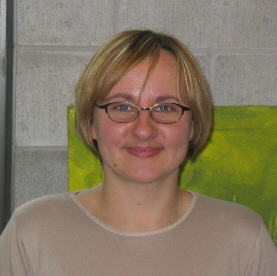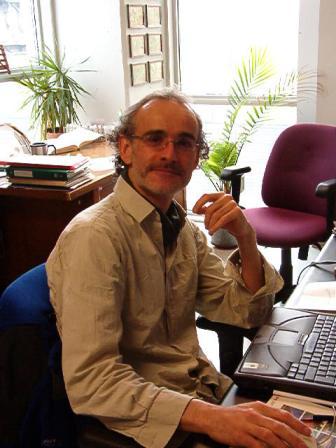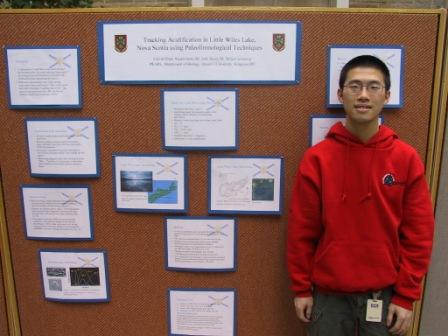 John Smol,
PhD - Queen's University
John Smol,
PhD - Queen's UniversityJohn Smol is a paleolimnologist, Biology professor, and co-director of the Paleoecological Environmental Assessment and Research Laboratory (PEARL) at the Queen's University Biology Department. His previous research has focused on lakes across North America (including climatic change in the High Arctic and assessing acid deposition in both Ontario and the Northeastern USA) and also in Europe. The buttons below link to John's e-mail and biography page.
![]()
![]()
 Brian Cumming,
PhD - Queen's University
Brian Cumming,
PhD - Queen's University
Brian Cumming is a paleolimnologist, Biology professor at Queen's, and co-director of the Paleoecological Environmental Assessment and Research Laboratory (PEARL). His previous research has focused on lake acidification in the Northeastern USA as well as climatic, and other effects on lakes in Western Canada, Ontario, and East Africa. The buttons below link to Brian's e-mail and biography page.
Photo of Brian Cumming and "field assistant" on location at Quetico Provincial Park (Ontario). Please note that photo was staged and PEARL endorses the use of required safety equipment when using recreational vehicles.
 Peter Dillon,
PhD - Trent University
Peter Dillon,
PhD - Trent University
Peter Dillon specializes in biogeochemical modeling on lakes and catchments, is a professor with the Departments of Environmental and Resource Studies and Chemistryat Trent University, and is Director of the Water Quality Centre. The buttons below link to Peter's e-mail and lab website.
Graduate Students and Post-Doctoral Fellows
 Brian Ginn (Post-doctoral
Fellow -
Queen's University)
Brian Ginn (Post-doctoral
Fellow -
Queen's University)
Brian completed his PhD in April, 2006 on
using paleolimnology to track acidification in 51 NOva Scotia study lakes.
He is now shifting focus to the eutrophication side of the project and will
be studying the impact of development on lakes in Cape Breton Highlands
National Park, and the impact of suburban development in six Halifax lakes.
TEAM Fact: One truck backing up, one Biology building - we think the rest is self-explanatory.
 Marta Wolniewicz (PhD
Candidate - Trent University)
Marta Wolniewicz (PhD
Candidate - Trent University)
Marta's research focuses on modeling acidification on lakes and revisions to the MAGIC model.
(Photo courtesy: Marta Wolniewicz)

Thiyake Rajaratnam (MSc Student - Queen's University)
Thiyake has a BSc (Honours) from Queen's majoring in Biology. Her project will focus on environmental change and the impact of development in 51 Halifax Region lakes.
(Photo courtesy: PEARL)

Christina Soliman (MSc Student - Trent University)
Christina received her B.Sc. from Trent University in 2004. Prior to University, Christina worked as an environmental consultant for 1 year and completed 3 years in college studying environmental science. Christina will be using the Lakeshore Capacity Model (LCM) to evaluate the effects and interactions of stressors (i.e. elevated nutrient levels) on the studied lakes and catchments. Also, she will use the LCM to address the effects of changes in land-use as it relates to deep-water oxygen concentrations in Nova Scotia brook trout lakes.
(Photo courtesy: Christina Soliman)
Others
who have assisted:
Jenny Korosi (Summer Research Assistant, Queen's, 2006)

Alyson Paul (Summer Research Assistant, Queen's, 2005)

Kyle Lauersen (Summer Research Assistant, Queen's, 2005)
Completed Projects
 Sergi Pla (Post-Doctoral Fellow
- Queen's)
Sergi Pla (Post-Doctoral Fellow
- Queen's)
Originally from Barcelona, Spain, Sergi has a PhD from the University of Barcelona and completed a 2 year post-doctoral fellowship at University College of London in England. Sergi used diatoms to study trends in eutrophication in the Nova Scotia brook trout lakes.
(Photo Courtesy: Brian Ginn)

Brian Ginn (PhD Candidate -
Queen's)
Originally from Saint John, NB, Brian
recently completed his PhD studying acidification trends in 51 Nova Scotia
lakes. His study involved constructing a 494-lake diatom-environment
calibration set from northeastern North America; comparing present-day and pre-impact diatom
assemblages to detail water quality changes; and an analysis to study decadal
changes in 14 lakes from Kejimkujik and Cape Breton Highlands National Parks,
tracking both the timing of acidification and the role of DOC.
TEAM Fact: One truck backing up, one Biology building - we think the rest is self-explanatory.
 Colin Whitfield (MSc
- Trent)
Colin Whitfield (MSc
- Trent)
Colin's research investigated lake catchment response to acidic deposition using a biogeochemical process-based model (MAGIC) to recreate past environmental conditions and simulate future conditions of 20 low-order (i.e. headwater) Nova Scotia LRTAP lakes. The use of process-based models, in combination with critical and target sulphate load estimates will enable evaluation of current recovery from acidification (if any) and, based on current sulphate scenarios, expected future recovery (or deterioration) of lakes. Model simulations were run under current climatic conditions, and future climate change scenarios, to compare and assess the potential impact of climatic change. (Photo Courtesy: Colin Whitfield)
 Anne Harris
(MSc - Queen's)
Anne Harris
(MSc - Queen's)
Hailing from Midland, Ontario, on the shores of
scenic Georgian Bay, Anne has a BSc (Hons) from Queen's University. Anne's research
will study the effects of acid deposition on lakes in New Brunswick using
diatoms as paleoecological indicators.
Using lakes from Environment Canada's and the Canadian Wildlife Service's LRTAP monitoring program, Anne will
study present-day and pre-impact diatom assemblages to track acidification
trends on all lakes as well as detailed analysis of selected lakes.
(Photo Courtesy: Anne Harris )
 Michael
Rate (MSc Student - Queen's)
Michael
Rate (MSc Student - Queen's)
Mike's research will also centre on acidifcation of the Nova Scotia
LRTAP lakes using scaled chrysophytes as a paleoecological indicator.
After constructing a chrysophyte-based calibration set, he will
use top-bottom analyses to track environmental changes that have occurred
in these lakes since pre-industrial times.
TEAM Fact: Proclaimed deep-fried pepperoni as the official TEAM appetizer and "Less than Jake" as the official theme music!
(Photo Courtesy:
Brian Ginn)
 Laura
Lawlor (MSc Student - Queen's)
Laura
Lawlor (MSc Student - Queen's)
Laura has a BSc, double-majoring in Biology and
Earth Sciences, from Dalhousie University (Halifax) and spent the past few
years working as an Environmental Consultant. Laura's project, in conjunction
with NS Inland Fisheries, will use fossils of chironomid (non-biting midge) larvae to study the effects
of changes in nutrient loading and productivity on brook trout in Nova Scotia
lakes. (Photo Courtesy:
Brian Ginn)

Joshua Thienpont (BSc Honours - Queen's, 2006-2007)
Josh's research will be using paleolimnology to study the impact of residential and cottage development on three lakes in King's County, NS.

Alexandra Gerber (BSc Honours - Queen's, 2006-2007)
Alex's thesis project focuses on using diatoms to track acidification-related changes in Glasgow Lake (Cape Breton Highlands National Park).

Laura Grace (BSc Honours - Queen's, 2005 - 2006)
Laura's BSc Honours thesis project studied environmental changes in lakes, near Bridgewater NS, which are habitat for the endangered Atlantic Whitefish.
 Erica
Johnson (BSc Honours - Queen's,
2004 - 2005)
Erica
Johnson (BSc Honours - Queen's,
2004 - 2005)
Erica's research focused on water quality changes (e.g., eutrophication and hypolimnetic anoxia) in Russell Lake in Dartmouth using fossil chironomid larvae as environmental indicators.
(Photo Courtesy: Brian Ginn)
 Amy
Tropea (BSc Honours - Queen's, 2004 - 2005)
Amy
Tropea (BSc Honours - Queen's, 2004 - 2005)
Amy's honours research studied water quality changes in two Halifax Region lakes (Russell Lake and Pockwock Lake) using diatoms as ecological proxy indicators.
(Photo Courtesy: Brian Ginn)
 Calvin Chan (BSc
Honours - Queen's,
2003-2004)
Calvin Chan (BSc
Honours - Queen's,
2003-2004)
Calvin's honours research focused on changes in Little Wiles Lake (near Bridgewater, NS) as related to acidification and watershed disturbance.
TEAM Fact: Calvin is the only TEAM member to have his
tent repeatly attacked by a red squirrel (Tamiasciurus hudsonicus) in
the Peskowesk backcountry of Kejimkujik National Park.
(Photo Courtesy:
Biol 537, Queen's University)
 Laura Stewart (BSc
Honours - Queen's,
2003-2004)
Laura Stewart (BSc
Honours - Queen's,
2003-2004)
Laura's research addressed the question of reproducibility of sediment in a large (2640ha) lake (i.e., is one core representative of the whole lake?) and tracked the timing of changes related to acid deposition in Kejimkujik Lake, Kejimkujik National Park, N.S.
TEAM Fact: Laura has the distinction of being the only TEAM member to be chased away from a study lake by a duck (in her defense it was rather ill-mannered).
(Photo Courtesy:
Biol 537, Queen's University)